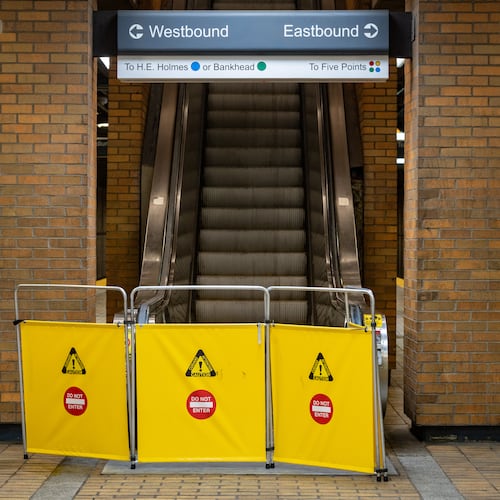The city hall and amphitheater are already there. Coming soon: a gymnasium, bowling alley, rooftop dining and much more.
Like many suburban cities across the metro area, the Gwinnett County community of Sugar Hill is making over its downtown to appeal to young millennials and retiring baby boomers who want walkable town centers with plenty to do.
Planning experts are not worried about redundancy as the new downtowns appear. Demand for denser communities that have the attractions and services similar to their urban neighbors far outpaces supply, they say. It’s a return to America’s roots.
“When malls started coming in the ’70s, existing small-town main streets took a real hit,” said Ellen Dunham-Jones, a professor of architecture and urban design at Georgia Tech. “As malls struggle, a lot of downtowns are coming back, increasingly now in the suburbs. Towns that really have existing downtowns, they’re reviving.”
From Peachtree City to Peachtree Corners, cities are spending millions to build parks, government buildings and entertainment spaces and to bring in developers who will create mixed-use areas replete with places to eat, shop, work and live.
Seeing the trend, some cities are building their downtowns anew. Others are looking at old buildings that used to constitute downtowns and deciding it’s time to bring them up to snuff.
“Millennials want the suburbs to look different,” said Sarah Kirsch, executive director of the Urban Land Institute’s Atlanta District Council. “They want it more walkable, more connected, more destinations. …They’re really driving demand in the suburbs.”
In addition to economic development opportunities, a new downtown is often a chance to define a city, old or new.
“It’s trying to be a place that provides a unique identity to that community,” Dunham-Jones said.
Sugar Hill, a 75-year-old city with a population of about 20,000, is essentially building from scratch. What is now the downtown district was once a window company, a church and mobile homes. The new amphitheater soon will host Travis Tritt, Sister Hazel, The Voice winner Danielle Bradbery and The Blues Brothers.
The city is planning a massive expenditure to build a downtown that includes a single-screen, first-run movie theater that can also be used for performing arts, a six-lane bowling alley, a gymnasium and several restaurants, all called the EpiCenter. A seasonal ice rink the size of Rockefeller Center’s is being considered as a year-round option. A co-work space is slated to open next month and a five-story mixed-use project is expected to break ground nearby over the summer.
Scott Andrews, the city’s communication and events manager, said city leaders don’t think people will commute from Atlanta for dinner. But with unique offerings, like an Irish ice cream pub that serves alcohol-infused confections, and the amount of development taking place, Andrews said he thinks area residents will be drawn downtown. Some, when they graduate from college, may want to come back to Sugar Hill.
“We’re trying to target people like me, who like the downtown life, but hate that drive,” said Andrews, who lives in Suwanee’s downtown. “We want people on Friday night to clock out of work and have a beer.”
Though much has been said about millennials’ desire for downtown living and access to transportation, the ‘burbs are counting on a wider definition of downtown than Atlanta’s skyscrapers. They say they don’t expect people to choose Sugar Hill over Midtown, but want those who have suburban jobs or who want access to better schools to have the lifestyle they seek without having to sacrifice commute times or educational opportunities.
The groundwork for suburban downtown revitalizations was set more than a decade ago by the Atlanta Regional Commission’s Livable Centers Initiative, said Dan Reuter, the ARC’s community development manager. It gave communities money to look at their historic downtowns through a new, urban lens. As a result, many conducted studies on how to urbanize their cores.
Dunham-Jones cautioned against the "insta-downtown," where pieces are interchangeable from one city to the next. While demand for walkable centers is there, they must be well-built, with interesting architecture and offerings, in order to succeed. Shoddy construction or too many chain stores will keep an area from being a draw.
David Belle Isle, the mayor of Alpharetta, got into politics because he wanted to create the downtown that the city didn’t have. Alpharetta is taking the pieces it likes from the region and the country — a fountain people can play in like the one in Duluth, for example, and a park like Suwanee’s that draws passersby in. Other elements were inspired by downtowns in Greenville, S.C. and Alexandria, Va.
Alpharetta's downtown will be just half a mile from the new Avalon development, a gigantic mixed-use center. Belle Isle sees that as an advantage and is focused on creating pedestrian walkways and bicycle lanes that will allow people to connect between the two. Alpharetta is trying to create an "irresistible city," he said.
“You’ve got to give them something to mentally identify with,” he said. “People are finding less and less reasons to ever leave Alpharetta. …People want that sense of place. They want to belong to a city.”
Johns Creek Mayor Mike Bodker wants to build a new downtown called The District on more than 700 acres. That ambitious project would attract young workers and help diversify the city’s tax base, he has said.
In Gwinnett, in particular, the number of downtown projects is high. The new city of Peachtree Corners is building theirs from scratch on land the city bought across from the Forum shopping center. That city hopes to connect businesses with green space and put denser living options in what are now office parking lots.
Lilburn is realigning a road to make its downtown more developable and is building a joint city hall-library that will anchor the area. In Duluth, the city intends to add a residential component near its existing downtown and has big plans for a block of old commercial space across from its Town Green. A new park in Lawrenceville called the Lawn has opened up demand from developers and made its existing areas more interesting for locals — including students at the nearby Georgia Gwinnett College, who leaders hope will decide to stay in Lawrenceville once they graduate.
“It’s getting them to claim it as their own,” Lawrenceville Mayor Judy Jordan Johnson said. “All we can do is plant the seed.”
Both millennials and boomers are deciding where to live based on where they want to spend their time, Johnson said. For that reason, she sees opportunities for all of the region’s downtowns to succeed.
“Each of us offers something appealing to the citizens,” she said. “I don’t necessarily see it as competition.”
About the Author
The Latest
Featured


